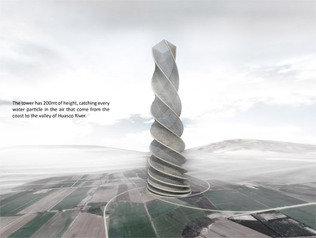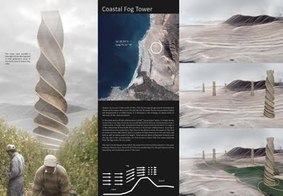Coastal Fog Tower - Huasco, Chile
- Huasco is a port city in the north of Chile. The city has a significant agricultural industry irrigated by the Huasco River, but in the last decade the river’s water levels have decreased making irrigation from the river impossible in the mid-term.
- A climatic phenomenon of the area called Camanchaca, a type of very dense coastal fog that has dynamic characteristics: one is condensation that is displaced towards coastal zones by the wind. The condensation originates in the anticyclone of the Pacific that produces a cloud layer stratocumulus, which persistently covers the coastal strip from Peru to northern Chile.
- The tower is 200m high and catches every water particle in the air that comes from the coast into the valley of the Huasco River.
- The water yield is projected to be 2 to 10L/m2 of vertical surface. Each tower has a vertical surface of 5,000m2, producing a minimum of 10,000L/day, and an impressive peak output of 50,000L/day. This quantity of water renders viable the agricultural industry of this arid coastal area.
- This project demonstrates how it is possible create new development and better opportunities using nonconventional natural resources. The tower enables
equitable access to water supplies that are made available not only to those people adjacent to the river.
www.holcimfoundation.org/Portals/1/docs/A08LA/08_LATAM_NextGen_2.pdf


